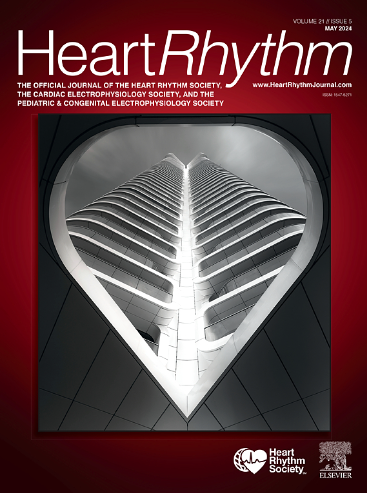与原发性持续性心房颤动相比,阵发性心房颤动史与首次心脏复律后更早复发有关。
IF 5.6
2区 医学
Q1 CARDIAC & CARDIOVASCULAR SYSTEMS
引用次数: 0
摘要
背景:阵发性心房颤动(pAF阵发性心房颤动(paroxysmal atrial fibrillation,pAF)可能会通过心脏重塑发展为持续性心房颤动(persistent atrial fibrillation,psAF)。然而,有些患者在出现持续性心房颤动(psAF)时并无先前的心房颤动病史。先前的心房颤动病史可能会影响直流电心律转复术(DCCV)后的复发:目的:确定与无 pAF 既往史的患者相比,pAF 既往史是否与 DCCV 后复发率的差异有关:退伍军人事务中心的前瞻性程序数据库确定了 565 名因 psAF 首次接受 DCCV 的患者。初始心律史按先前的 pAF 区分,没有 pAF 的患者被视为原发性 psAF。心电图随访在心脏复律后 1 个月和 3 个月进行:结果:首次因 psAF 接受 DCCV 的患者更有可能出现原发性 psAF(81.6%)。pAF患者的左心房大小相似,但更有可能患有慢性肾病、睡眠呼吸暂停、中风以及在心脏复律时服用抗心律失常药物。pAF患者复发较早,中位房颤存活时间较短,为1.6个月,而pAF患者为5个月(Kaplan-Meier图,P=0.0101)。在控制了AAD的使用后,这一差异依然存在。复发类型大多为持续性房颤,两组患者的情况相似:结论:与有过房颤病史的患者相比,原发性房颤患者对 DCCV 的反应可能更持久。因此,由于使用 DCCV 后复发的可能性更高,pAF 患者可能会从更积极的早期节律控制策略中获益。本文章由计算机程序翻译,如有差异,请以英文原文为准。
Paroxysmal atrial fibrillation history is associated with earlier recurrence after first cardioversion compared with primary persistent atrial fibrillation
Background
Paroxysmal atrial fibrillation (pAF) may progress through cardiac remodeling to persistent atrial fibrillation (psAF). However, some may present in psAF without a preceding history of pAF. A preceding history of pAF may affect recurrence after direct current cardioversion (DCCV).
Objective
The aim of this study was to determine whether a preceding history of pAF is associated with a difference in recurrence rates after DCCV compared with patients without a preceding history of pAF.
Methods
A prospective procedural database at a Veterans Affairs center identified 565 patients who underwent their first DCCV for psAF. Initial rhythm history was separated by prior pAF, and those with none were considered primary psAF. Electrocardiography follow-up was standardized at 1 month and 3 months after cardioversion.
Results
Patients who underwent their first DCCV for psAF were more likely to have presented with primary psAF (81.6%). Those with pAF had a similar left atrial size but were more likely to have chronic kidney disease, sleep apnea, previous stroke, and use of antiarrhythmic drugs at the time of cardioversion. Patients with pAF had earlier recurrence and shorter median AF survival time, 1.6 months compared with 5 months (Kaplan-Meier plot, P = .0101). This difference persisted in controlling for antiarrhythmic drug use. Recurrence type was mostly persistent AF, similar in both groups.
Conclusion
Patients with primary psAF may have a more sustained response to DCCV compared with those with a preceding history of pAF. Thus, those patients with pAF may benefit from a more aggressive, early rhythm control strategy because of higher likelihood of recurrence with DCCV.
求助全文
通过发布文献求助,成功后即可免费获取论文全文。
去求助
来源期刊

Heart rhythm
医学-心血管系统
CiteScore
10.50
自引率
5.50%
发文量
1465
审稿时长
24 days
期刊介绍:
HeartRhythm, the official Journal of the Heart Rhythm Society and the Cardiac Electrophysiology Society, is a unique journal for fundamental discovery and clinical applicability.
HeartRhythm integrates the entire cardiac electrophysiology (EP) community from basic and clinical academic researchers, private practitioners, engineers, allied professionals, industry, and trainees, all of whom are vital and interdependent members of our EP community.
The Heart Rhythm Society is the international leader in science, education, and advocacy for cardiac arrhythmia professionals and patients, and the primary information resource on heart rhythm disorders. Its mission is to improve the care of patients by promoting research, education, and optimal health care policies and standards.
 求助内容:
求助内容: 应助结果提醒方式:
应助结果提醒方式:


